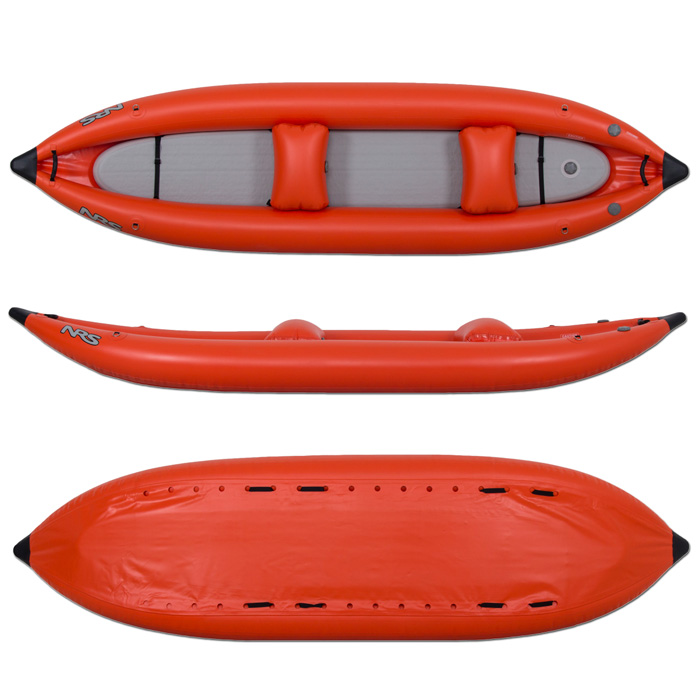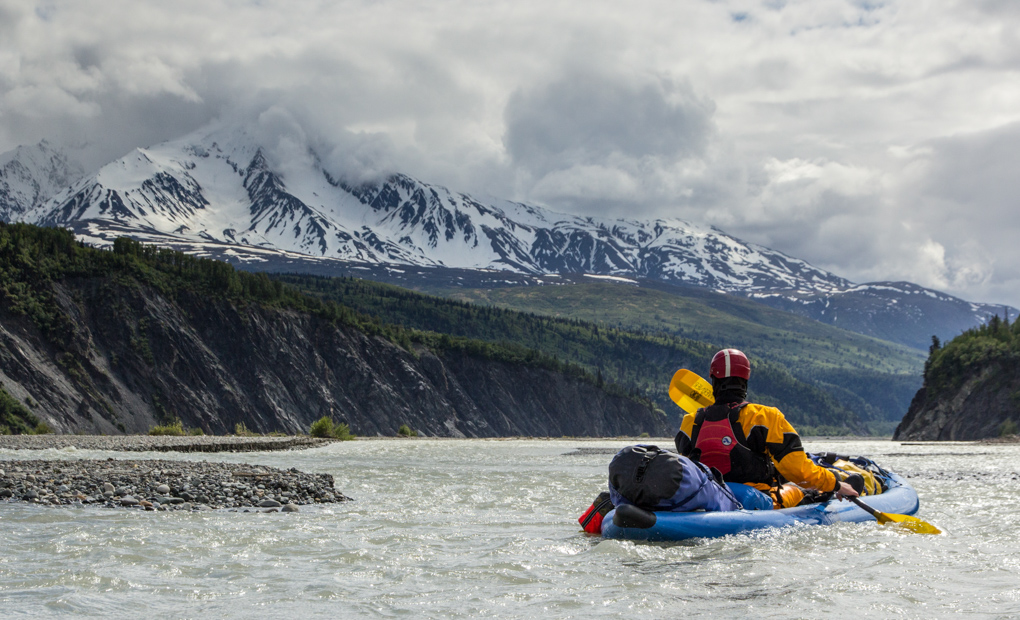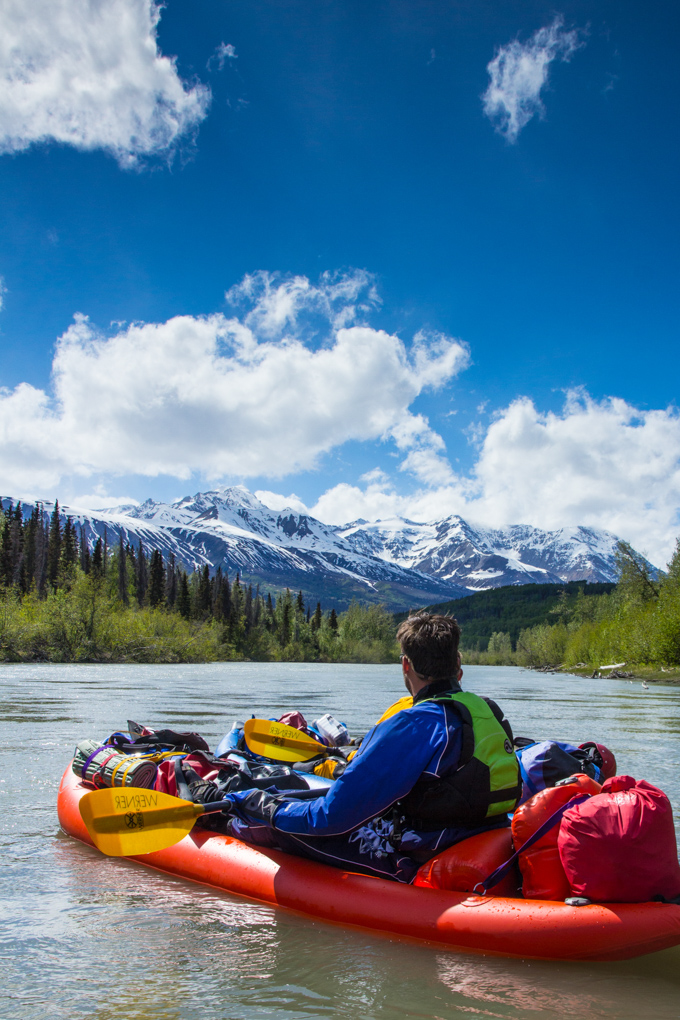
NRS Outlaw II Inflatable Kayak
MSRP: $795
Manufacturer Specs:
- PVC-coated polyester material
- Length / width: 12’2″ / 39″
- Weight: 34 lbs
- Tube diameter: 10.5″
- Bow & stern kick: 16″
- 3-year retail warranty
Reviewer Stats: 6′, 185 lbs
Conditions Tested: Low volume tight & technical, pushy big water, expedition paddling, tandem and solo
Locations Tested: Alaska, New Mexico, Colorado, and Utah
Days Tested: 30
Inflatable Kayaks (IKs) are often geared toward beginner paddlers who want a low-consequence way to travel down the river. IKs are easily transportable because they inflate like a raft, and allow the user to sit on top and paddle, instead of committing to an enclosed cockpit and spray skirt. They are also easy to re-enter in the event of a flip/swim. These characteristics make them excellent crafts for beginners who are nervous about hardshell kayaks.
I quickly realized IKs’ versatility for expedition paddling when two friends and I used tandem IKs on a multi-day trip down the Tatshenshini and Alsek Rivers in Alaska. IKs proved to be a great alternative to hard-shelled kayaks because they are capable of transporting expedition gear, and were easy to carry on the bush plane flight out from Dry Bay, AK.
I used the tandem NRS Outlaw II IK as a solo craft on the Tatshenshini River to carry sufficient food and gear for 12 days on the water. I’ve also tested the NRS Outlaw II as a tandem craft for day trips and shorter overnighters.
Design & Construction
The Outlaw II is the most basic, budget-oriented tandem IK that NRS makes. It replaced the older Bandit models, which were constructed with a stronger and lighter urethane coated nylon material. NRS decided the material was too expensive for the price point, so they kept many of the same design features and released the Outlaw Series with a new material. The Outlaw Series has a PVC-coated polyester construction, is just a tad wider than the Bandit design, and has a removable drop-stitch floor. The Outlaw II features two air chambers for the tubes, and an additional air chamber for the removable floor. Two inflatable thwarts are provided for use as seats.
My first impression when I got in the Outlaw II was how stiff the floor was at the rated 10 psi. The drop-stitch construction allows for high-pressure inflation, which provides stiffness to the design. Drop-stitch construction eliminates the need for baffles because the top and bottom pieces of material are joined by thousands of tiny polyester threads that enable high-pressure inflation.
The width is generous for a tandem IK, which makes it more stable to the benefit of beginners and veteran whitewater paddlers alike. The downside to this width is that the Outlaw II is slower and does not track as well. Assuming the Outlaw II is used for whitewater, these aren’t huge issues. I’ve heard of people gluing on fins to enable better tracking in flat water.

Each end of the boat has 16” of kick rocker, which helps the bow ride up and over most waves instead of piercing them and taking on water in the boat. Additionally, the rocker makes the 12’2” boat more maneuverable for its length, especially when manned by a solo paddler. The floor insert is 4” thick, which works well for lighter loads, but may be insufficient for heavier ones.
There are two stainless steel D-rings near the bow and two near the stern, which make securing gear loads fairly simple. Additionally, there are rubberized bow and stern handles for easy carrying, which could also be used as tie-down points.
The Leafield C7 valves used in the Outlaw series seem bombproof and none of us had any issues with the valves while on our expedition.
The self-bailing design is achieved by drain holes punched in the floor directly on the inner length of the tubes. Unfortunately, the drop-stitch floor insert covers these drain holes and interfaces pretty tightly with the tube, which prevents water from easily draining. This was an issue on our trip and I’ll get into it more later.
The 34 lb. weight enabled easy transporting, and could be managed by one person for carrying. Portability is a major advantage of IKs, and it is easy to stash a deflated, rolled-up Outlaw II in the trunk on the drive to a river. This also makes IKs ideal expedition boats when it may not be feasible to fit multiple hard-shelled kayaks or a larger raft in a small bush plane.
Performance
The Outlaw II performed admirably on wide, big water rivers in Alaska and Colorado, but performance suffered on the tight, technical runs in Colorado like the Royal Gorge of the Arkansas. Paddling the Outlaw II solo on a tight run wasn’t a problem, but introducing another paddler up front, along with light overnight gear, made the boat sluggish and quite difficult to maneuver. Simply said, the IK was overloaded and there was too much weight in the front.
If you’re looking to paddle non-technical rivers with a friend and overnight gear, the Outlaw II will shine. On the other hand, a fully loaded Outlaw II won’t work well if you want to do an overnight trip on a technical, rocky piece of whitewater that demands maneuverability. If you’re just taking the Outlaw II on a short day trip, the boat will feel more responsive due to the lighter weight involved.
NRS doesn’t state a specific weight limit for the Outlaw II, but I’ve found that 350 lbs is just about the upper limit. Anything more than that, the performance will suffer considerably in whitewater, and you’ll likely be sitting in water, as the floor isn’t substantial enough for that weight.
Drainage was immediately an issue with the Outlaw II. The drain holes on the underside of the IK are located right below the junction of the floor insert and tubes. Thus if the floor is highly inflated, the water doesn’t drain effectively and quickly accumulates in the boat. It only takes a couple of inches of water to feel like you’re swimming inside of the boat, and full drainage takes at least 30 seconds if you’re swamped.
We experimented by deflating the floor a bit to see if that allowed faster drainage, but it didn’t help. And we found that fully inflating the floor is necessary for flotation, which is critical when you have a heavy load. Be aware that a large splash from a wave might leave you swamped. Continuous rapids raise the probability of taking on water and are much harder to navigate than short rapids with a single move.

Thigh straps are not included with the Outlaw II, but you can purchase them separately through NRS. Thigh straps function much like thigh braces in a hard-shell kayak, enabling the paddler to pull up on their thighs and control the lean of the boat with their body. Having thigh straps will greatly increase your ability to control the boat, and will also prevent you from falling out.
I’ve never tested rolling with the straps, although the IK’s width would likely make this difficult. Either way, falling out and climbing back in is a cinch. We didn’t bring thigh straps, but compensated by digging our toes under the drybags up front, and using that leverage to brace the boat.
The high-pressure floor helped keep the Outlaw II stiff and made it easy to punch through waves without feeling the boat fold and flop. A slight “taco” effect will occur with two paddlers in the boat going through a large ledge hole, but this is pretty much unavoidable with any inflatable of this type – you can only achieve a certain level of rigidity with any inflatable craft.
The Outlaw II is stiff and stable enough for us to stand on the floor and paddle it in a style akin to a SUP board. Overall, the boat’s whitewater performance was not astoundingly good, but for a budget IK, the Outlaw II performed as expected, and was predictable and stable in whitewater.
NEXT: Safety, Durability, and Comfort

Going to get. Looks fantastic :D
I am using AIRE Super Lynx Kayak. It’s very nice and feeling comfortable. According to your Description “NRS Outlaw II Inflatable Kayak” will also better and Low prices.
Thanks for the in-depth review!
The newer models have solved the problem with self bailing drain holes. Their is now some space between the floor and side tubes to make for easier drainage.
Eh, I got what I think is a newer model, and I still sit in water. Beautiful boat, love it, but your fanny does get wet.:)